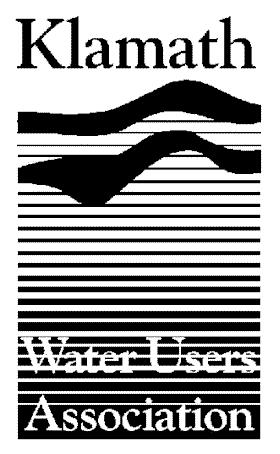The Long Lake project has been
effectively promoted by the Klamath County commission. My
organization, the Klamath Water Users Association, is one of more than
20 groups - including five California and Oregon counties - who
support continued study of Long Lake.
Last December, Reclamation officials
released a preliminary assessment, which suggested that a full-blown
study of Long Lake would take up to four years and cost up to $10
million. Reclamation's report further noted that building the project
would cost more than half a billion dollars.
This finding was based on an update of
costs previously developed by Reclamation in a 1987 report. Earlier
this year, directed its engineering consultant - MBK Engineers of
Sacramento - to review both of Reclamation's studies. MBK's review
discusses the main items that each study examined, and reports their
findings.
Reclamation's Upper Klamath Offstream
Storage Study was issued in 1987. The study examined the construction
and operation of three potential offstream reservoirs: Long Lake,
Round Lake and Aspen Lake. The report found that none of the studied
project alternatives produced an adequate cost-benefit ratio, and thus
none were considered economically viable. Lack of demand for
additional power was the primary reason for the low benefit-cost
ratios.
Benefits not included
The purpose of the 2003 Reclamation
analysis was to update construction costs associated with the 1987
study. The costs of a Long Lake-only project were estimated in this
work to be $510 million (no reservoir lining) and $690 million (3-foot
impervious lining).
Our engineers found that this report had
no significant specific findings other than the updated construction
and implementation costs. The benefits were not re-characterized, and
the cost-benefit analyses performed in the 1987 report were not
performed again. Notably, no consideration was given to the potential
benefits provided by these projects for contributing to Endangered
Species Act-related Klamath River instream flow requirements or Upper
Klamath Lake levels.
Reclamation's work on Long Lake has not
addressed the impact generated by the additional demand for water
resulting from endangered species regulations imposed in the past
decade. Obviously, based on the disastrous 2001 water curtailment to
Klamath Reclamation Project irrigators, there are significant costs
associated with adhering to rigid lake level and flow requirements in
the Klamath River. In order to accurately assess the feasibility of an
offstream storage project in the Upper Klamath Basin, an analysis of
how these costs might be alleviated with expanded water supplies must
be performed.
We also recommend that a comprehensive
study examine a range of potential conveyance capacities for the
pipeline carrying water from Upper Klamath Lake to Long Lake
reservoir. While the 2003 construction cost update assumed a capacity
of 2,000 cubic feet per second, Reclamation failed to justify the
selection of this capacity. The pumping and pipe capacity should be
based on a water supply analysis showing the availability of excess
water that could be used to fill the reservoir.
For this analysis, a range of capacities
should be examined in order to pinpoint the economically optimal
value. Preliminary analysis conducted by others indicates that a
reduced capacity of as low as 750 cfs would provide adequate Long Lake
water supply. This capacity reduction results in a corresponding
reduction of approximately $45 million from the 2003 Reclamation
project cost estimate.
The geologic study just released by
Reclamation shows that water will not leak from the bottom of Long
Lake Valley, which means that a smaller Long Lake storage project
could be put in place without constructing a dam or lining the
reservoir. Our engineers estimate that removing the dam and reservoir
lining from the project would drop Reclamation's 2003 cost estimate by
another $131 million. With these considerations, the Long Lake project
begins to look much more feasible.
Local water users view the current
Klamath Project Environmental Water Bank - a mandatory requirement
imposed by the coho salmon biological opinion from the National
Oceanic and Atmospheric Administration's National Marine Fisheries
Service - as an interim measure that should only be employed to
compensate irrigators for voluntary action in drier years.
Storage a key
Ultimately, the resources of the Klamath
Basin can best be satisfied through the development and crediting of
new water storage facilities and effective restoration. As new surface
storage facilities are developed, the yield generated by those
facilities should directly reduce - and ultimately eliminate the need
for - the amount of water required by the water bank.
Reclamation has made some progress
towards completing feasibility studies authorized by the 2000
Enhancement Act. However, in the past four years, it has been
hamstrung from aggressively moving forward with these studies because
of the annual crisis-driven nature that has characterized recent
Klamath Project management.
Until recently, Reclamation appeared
reluctant to move forward with studying Long Lake because of the
perceived high costs associated with it. Reclamation's recent geologic
study, however - coupled with the preliminary findings of MBK -
suggest that this project has merit, and that additional investigation
should proceed, post haste.
Despite incorrect assertions from some
Klamath Project critics, our association has not put all its eggs in
the Long Lake "basket."
We believe that significant questions
remain to be answered, and that this project should be evaluated
relative to other potential projects, including the Barnes property,
Swan Lake and other proposals, using the same screening criteria. For
the projects that survive the screening, we should accelerate and
focus our efforts to construct them. For the ones that don't measure
up - put them on the shelf for consideration at some point in the
future. The 2000 Enhancement Act provides the authority to do this.
Let's get on with it.
